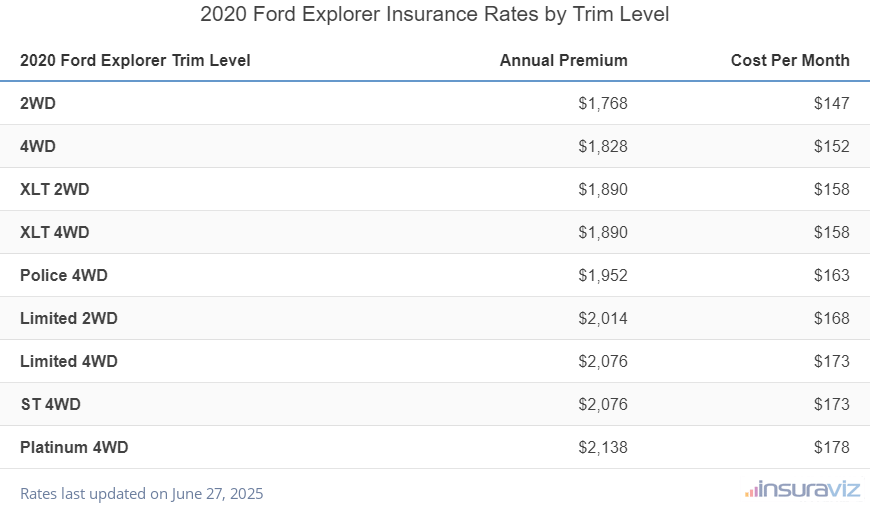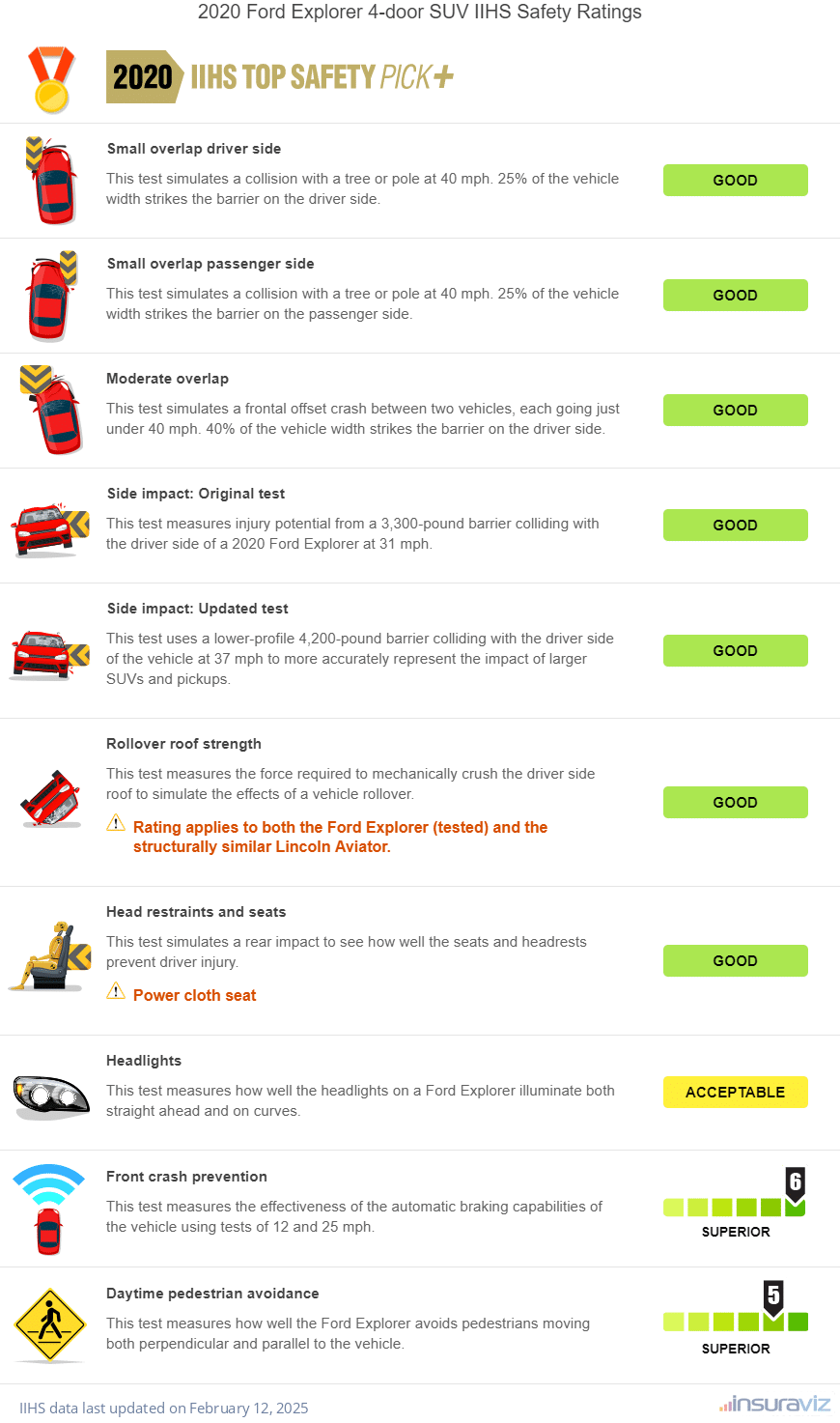This article not only breaks down the average rates you can expect to pay to insure a 2020 Ford Explorer, but it also examines how things like the trim level, policy deductibles, driver age, and safety rating all affect the cost of insurance.
Car insurance prices change regularly, so to check current rates, don’t hesitate to get free insurance quotes. You may find an affordable rate and there is never an obligation to buy.
The cost of 2020 Ford Explorer insurance
Insurance on a 2020 Explorer averages $2,006 per year, or about $167 per month. It’s one of the more competitive models to insure when compared to the entire 2020 midsize SUV segment, costing $78 less than the segment average rate of $2,084.
2020 models like the Ford Edge, Honda Passport, Kia Telluride, and Honda Pilot are all cheaper to insure than the Explorer, but the Explorer is cheaper to insure than the GMC Acadia, Chevy Traverse, Nissan Pathfinder and Toyota Highlander.
The chart below shows how the 2020 Explorer compares to some of the other models in the 2020 midsize SUV segment. To see a table comparing all 28 models in the segment, click the table button in the lower-left corner of the chart.
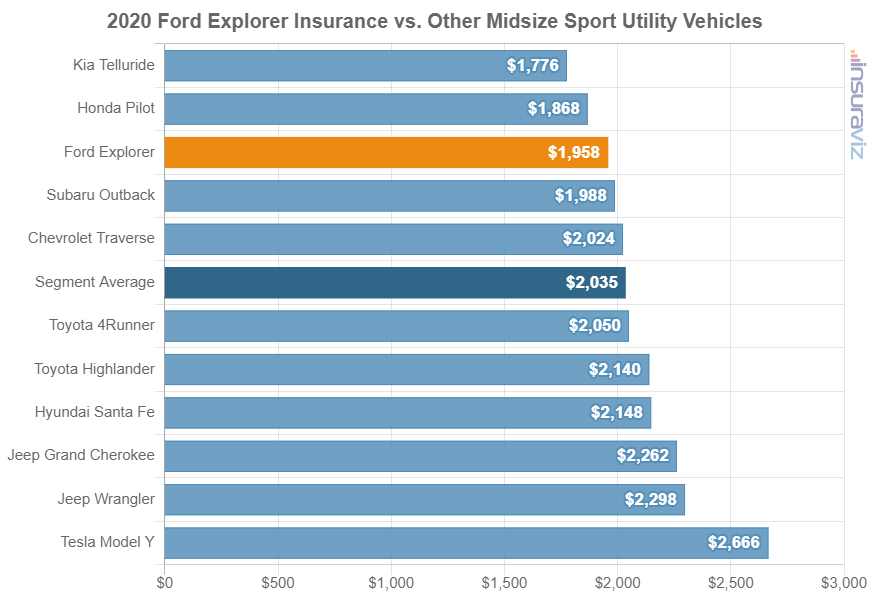
There are many different possible insurance rates based on factors like the age of the driver, their driving record, the deductible on the policy, and much more.
The next chart shows how much these different factors can impact rates on a 2020 Explorer. The average rate referenced in the chart above is the ‘Safe Driver Age 40’ rate shown in the chart below. So you can see how much prices can vary from this average rate.

The most affordable 2020 Ford Explorer model to insure
Depending on the trim level of your Explorer, rates can again vary quite a bit. Rates for different 2020 trim levels range from $1,810 per year on the base 2WD trim to $2,190 per year on the Platinum 4WD model.
There are exceptions, but generally, as you add options and the price goes up, the more insurance also costs. For most vehicles, the cheapest model you can purchase is generally the cheapest to insure as well.
The following table details average insurance rates for all 2020 Ford Explorer models. Rates are included for both annual and semi-annual policy terms, also including the monthly budget expense amount.
| 2020 Ford Explorer Trim Level | Annual Premium | Cost Per Month |
|---|---|---|
| 2WD | $1,810 | $151 |
| 4WD | $1,872 | $156 |
| XLT 2WD | $1,936 | $161 |
| XLT 4WD | $1,936 | $161 |
| Police 4WD | $1,998 | $167 |
| Limited 2WD | $2,064 | $172 |
| Limited 4WD | $2,126 | $177 |
| ST 4WD | $2,126 | $177 |
| Platinum 4WD | $2,190 | $183 |
Data Methodology: Rated driver is a 40-year-old married male with no driving violations or at-fault accidents in the prior three years. Comprehensive and collision deductibles are $500 and UM/UIM and medical payments coverages are included. Updated October 24, 2025
Accidents, violations, and the effect on car insurance rates
If you don’t have a perfect driving record, you might be wondering how a ticket or an at-fault accident will impact the cost to insure a 2020 Ford Explorer.
Each insurance company handles violations and accidents a little differently, but the chart below shows the average impact on rates that a speeding ticket or an accident can have on rates for a 2020 Explorer.

In the example, a 30-year-old driver who gets a serious speeding ticket can expect an average rate increase of around $530.
For an at-fault chargeable accident, the same driver can expect a rate increase of around $830.
And for a serious driving conviction like a DUI, their rate could go up by $1,870 or more per year.
Some companies do offer accident forgiveness, but you usually need to be insured for a specified number of years without an accident in order for this benefit to apply.
Car insurance rates for teen drivers
The 2020 Explorer is a solid choice for a teenager due to its safety ratings, but the cost of insurance may be somewhat prohibitive.
Teenagers are expensive to insure on pretty much any vehicle, but when they drive a new enough vehicle to carry full-coverage insurance, the cost can be very expensive.
That’s why the majority of vehicles in high school parking lots are older models and are probably only insured with liability insurance rather than full coverage.
Parking lots are one of the biggest causes of car insurance claims and injuries. Over 20% of car insurance claims are the result of accidents in parking lots.
The chart below shows average insurance rates for teenage drivers on a 2020 Ford Explorer. Prices range from a low of $4,762 to insure a 19-year-old female driver to a high of $7,133 to insure a 16-year-old male driver.
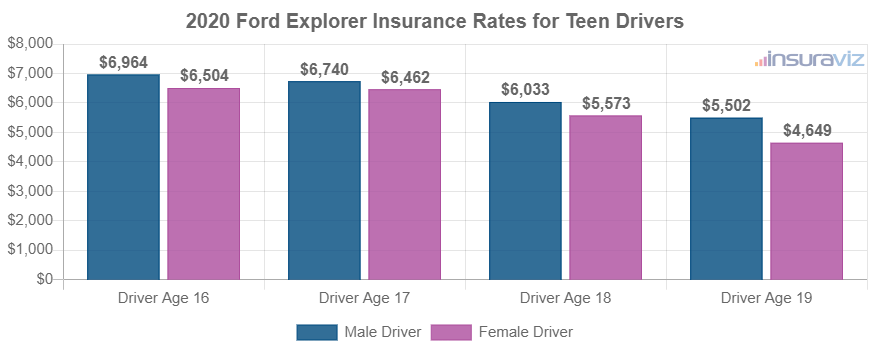
As mentioned earlier, insuring a vehicle with only liability insurance is a good way to keep costs down. If full coverage is a requirement, then you may consider raising the physical damage deductibles.
Here’s an example. A 17-year-old male driver with $500 deductibles on a 2020 Explorer will pay an average of $6,907 per year. When deductibles are raised to $1,000, the rate falls to $5,926.
Not many people would insure a 2020 Explorer with just liability insurance, but if you did, the chart below shows the difference between full coverage insurance and liability insurance for teen drivers on a 2020 Explorer.
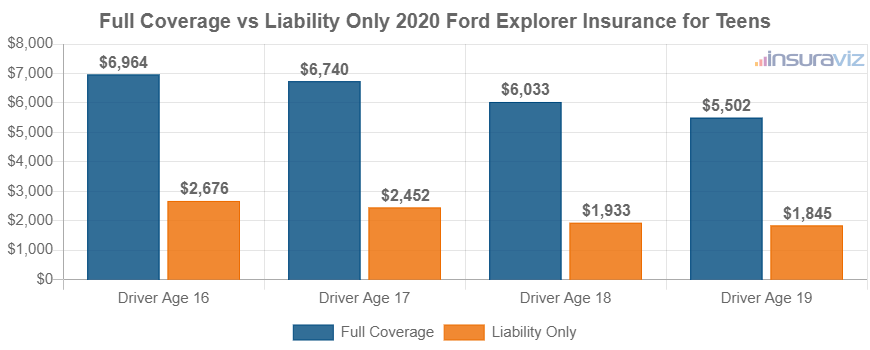
As you can see, for the same 17-year-old male from the previous example, the average rate for just liability insurance falls to $2,516 per year compared to $6,907 with $500 deductibles.
Again, it’s probably not realistic to insure a $30,000+ vehicle without having full comprehensive and collision insurance, but it does help you understand how much you can save with higher deductibles or liability-only insurance.
2020 Ford Explorer crash test and safety ratings
Is the 2020 Explorer a safe vehicle? Indeed it is.
It receives 5-star ratings for all NHTSA tests other than the rollover rating, which is to be expected for an SUV.
The table below details the results from the National Highway Traffic Safety Administration’s crash test results for both two-wheel drive and four-wheel drive 2020 Ford Explorer models.
| Rating Type | 2020 Ford Explorer SUV 4WD | 2020 Ford Explorer SUV RWD |
|---|---|---|
| Overall Safety Rating | ||
| Overall Front Crash Rating | ||
| Front Crash Driver | ||
| Front Crash Passenger | ||
| Overall Side Crash Rating | ||
| Side Crash Driver | ||
| Side Crash Passenger | ||
| Rollover Rating | ||
| Rollover Possibility | 15.1% | 14.7% |
Crash test rating data is from the National Highway Traffic Safety Administration. Complete data on the 2020 Ford Explorer including additional crash test results, vehicle recalls, and consumer complaints can be found on the NHTSA website.
The IIHS, or Insurance Institute for Highway Safety, is another independent, non-profit organization that performs crash tests on vehicles in order to determine their safety.
They perform some similar tests to the NHTSA, but the tests vary in many respects and they capture more information related to insurance industry interests.
The table below details the IIHS safety rates for a 2020 Ford Explorer as determined by IIHS. It received a 2020 IIHS Top Safety Pick+ award which is the highest rating given by IIHS.
| Small overlap driver side This test simulates a collision with a tree or pole at 40 mph. 25% of the vehicle width strikes the barrier on the driver side. | Good |
|---|---|
| Small overlap passenger side This test simulates a collision with a tree or pole at 40 mph. 25% of the vehicle width strikes the barrier on the passenger side. | Good |
| Moderate overlap This test simulates a frontal offset crash between two vehicles, each going just under 40 mph. 40% of the vehicle width strikes the barrier on the driver side. | Good |
| Side impact: Original test This test measures injury potential from a 3,300-pound barrier colliding with the driver side of a 2020 Ford Explorer at 31 mph. | Good |
| Side impact: Updated test This test uses a lower-profile 4,200-pound barrier colliding with the driver side of the vehicle at 37 mph to more accurately represent the impact of larger SUVs and pickups. | Good |
| Rollover roof strength This test measures the force required to mechanically crush the driver side roof to simulate the effects of a vehicle rollover.Rating applies to both the Ford Explorer (tested) and the structurally similar Lincoln Aviator. | Good |
| Head restraints and seats This test simulates a rear impact to see how well the seats and headrests prevent driver injury.Power cloth seat | Good |
| Headlights This test measures how well the headlights on a Ford Explorer illuminate both straight ahead and on curves. | Acceptable |
| Front crash prevention This test measures the effectiveness of the automatic braking capabilities of the vehicle using tests of 12 and 25 mph. | |
| Daytime pedestrian avoidance This test measures how well the Ford Explorer avoids pedestrians moving both perpendicular and parallel to the vehicle. | |
Full test rating data on the 2020 Explorer can be seen on the IIHS website.
Note that the safety award only applies to Explorer models built after May of 2020. This is due to the fact that Ford redesigned the left and right front subframe structure to improve occupant protection.
Initial tests on Explorer models prior to May, 2020, only received an ‘Acceptable’ rating for driver lower leg and foot injuries. After the subframe redesign, the Explorer received a ‘Good’ rating which enabled it to receive the Top Safety Pick+ designation.

